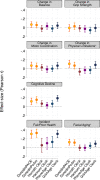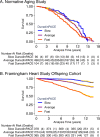DunedinPACE, a DNA methylation biomarker of the pace of aging
- PMID: 35029144
- PMCID: PMC8853656
- DOI: 10.7554/eLife.73420
DunedinPACE, a DNA methylation biomarker of the pace of aging
Abstract
Background: Measures to quantify changes in the pace of biological aging in response to intervention are needed to evaluate geroprotective interventions for humans. Previously, we showed that quantification of the pace of biological aging from a DNA-methylation blood test was possible (Belsky et al., 2020). Here, we report a next-generation DNA-methylation biomarker of Pace of Aging, DunedinPACE (for Pace of Aging Calculated from the Epigenome).
Methods: We used data from the Dunedin Study 1972-1973 birth cohort tracking within-individual decline in 19 indicators of organ-system integrity across four time points spanning two decades to model Pace of Aging. We distilled this two-decade Pace of Aging into a single-time-point DNA-methylation blood-test using elastic-net regression and a DNA-methylation dataset restricted to exclude probes with low test-retest reliability. We evaluated the resulting measure, named DunedinPACE, in five additional datasets.
Results: DunedinPACE showed high test-retest reliability, was associated with morbidity, disability, and mortality, and indicated faster aging in young adults with childhood adversity. DunedinPACE effect-sizes were similar to GrimAge Clock effect-sizes. In analysis of incident morbidity, disability, and mortality, DunedinPACE and added incremental prediction beyond GrimAge.
Conclusions: DunedinPACE is a novel blood biomarker of the pace of aging for gerontology and geroscience.
Funding: This research was supported by US-National Institute on Aging grants AG032282, AG061378, AG066887, and UK Medical Research Council grant MR/P005918/1.
Keywords: DNA methylation; aging; biological aging; biomarker; epidemiology; epigenetic; epigenetics; genetics; genomics; gerontology; geroscience; global health; healthspan; methylation.
Conflict of interest statement
DB, AC, DC, KS, RP, TM is listed as an inventor on a Duke University and University of Otago invention that was licensed to a commercial entity, LA, AB, KC, XG, EH, HH, RH, MK, DK, JM, JS, PV, CW, BW No competing interests declared
Figures
















References
-
- Ballinger GA. Using Generalized Estimating Equations for Longitudinal Data Analysis. Organizational Research Methods. 2016;7:127–150. doi: 10.1177/1094428104263672. - DOI
-
- Bell B, Rose CL, Damon A. The Normative Aging Study: An Interdisciplinary and Longitudinal Study of Health and Aging. Aging and Human Development. 1972;3:5–17. doi: 10.2190/GGVP-XLB5-PC3N-EF0G. - DOI
Publication types
MeSH terms
Substances
Associated data
Grants and funding
- R01 ES025225/ES/NIEHS NIH HHS/United States
- HHSN268201500001C/HL/NHLBI NIH HHS/United States
- R01 HD077482/HD/NICHD NIH HHS/United States
- N01 HC025195/HL/NHLBI NIH HHS/United States
- MR/P005918/1/MRC_/Medical Research Council/United Kingdom
- R01 AG032282/AG/NIA NIH HHS/United States
- P30 ES009089/ES/NIEHS NIH HHS/United States
- R01 ES021733/ES/NIEHS NIH HHS/United States
- R01 AG061378/AG/NIA NIH HHS/United States
- HHSN268201500001I/HL/NHLBI NIH HHS/United States
- R01 AG066887/AG/NIA NIH HHS/United States
- R01 ES027747/ES/NIEHS NIH HHS/United States
- G1002190/MRC_/Medical Research Council/United Kingdom
- 75N92019D00031/HL/NHLBI NIH HHS/United States
- MR/N01104X/1/MRC_/Medical Research Council/United Kingdom
- WT_/Wellcome Trust/United Kingdom
LinkOut - more resources
Full Text Sources
Other Literature Sources
Medical

